1. Choi SK. Women’s dietary problems over the life course. Health Welf Policy Forum. 2021; 299:6–18.
2. Ministry of Health and Welfare, Korea Disease Control and Prevention Agency. Korea Health Statistics 2021: Korea National Health and Nutrition Examination Survey (KNHANES VIII-3). Cheongju: Korea Disease Control and Prevention Agency;2022.
3. Lee RZ, Kim JH. Analysis of dietary behaviors, food consumption frequency and blood clinical indices by residence types of female college students in Seoul. Korean J Community Nutr. 2019; 24:183–196.
4. Rani R, Dharaiya CN, Singh B. Importance of not skipping breakfast: a review. Int J Food Sci Technol. 2021; 56:28–38.
5. Bonnet JP, Cardel MI, Cellini J, Hu FB, Guasch-Ferré M. Breakfast skipping, body composition, and cardiometabolic risk: a systematic review and meta-analysis of randomized trials. Obesity (Silver Spring). 2020; 28:1098–1109. PMID:
32304359.
6. Bae YJ, Kim EY, Yeon JY, Cho HK, Lee JS, Kim MH, Kim MH. Evaluation of dietary behavior, nutrient and food intake status, and dietary quality based on Diet Quality Index-International (DQI-I) in female university students. J East Asian Soc Diet Life. 2010; 20:491–501.
7. Jung HS, Kim JJ. Study on breakfast habits of workers and college students in Gyeongnam area. Korean J Food Cookery Sci. 2010; 26:791–803.
8. Yun SJ, Jeong HR, Kim MH. A survey on the breakfast skipping rate of Korean adults relative to their lifestyle and breakfast skipping reasons and dietary behavior of breakfast skippers. Korean J Community Nutr. 2010; 15:191–205.
9. Pendergast FJ, Livingstone KM, Worsley A, McNaughton SA. Correlates of meal skipping in young adults: a systematic review. Int J Behav Nutr Phys Act. 2016; 13:125. PMID:
27905981.
10. Kim DM, Kim YR, Kim KH. Dietary habits and nutritional status of young women according to breakfast frequency in Seoul. Korean J Community Nutr. 2018; 23:102–115.
11. Díaz-Torrente X, Quintiliano-Scarpelli D. Dietary patterns of breakfast consumption among Chilean university students. Nutrients. 2020; 12:552. PMID:
32093261.
12. Kelder SH, Hoelscher D, Perry CL. How individuals, environments, and health behaviors interact. Glanz K, Rimer BK, Viswanath K, editors. Health Behavior: Theory, Research, and Practice. 5th ed. San Francisco (CA): Jossey-Bass;2015. p. 159–181.
13. Askari S, Salimi N, Bakhshi E. Predictors of breakfast consumption among Iranian students: applying social cognitive theory. Russian Open Med J. 2022; 11:e0208.
14. Kim MJ, Kim KW. Nutrition knowledge, outcome expectations, self-efficacy, and eating behaviors by calcium intake level in Korean female college students. Nutr Res Pract. 2015; 9:530–538. PMID:
26425284.
15. Montaño DE, Kasprzyk D. Theory of reasoned action, theory of planned behavior, and the integrated behavioral model. Glanz K, Rimer BK, Viswanath K, editors. Health Behavior: Theory, Research, and Practice. 5th ed. San Francisco (CA): Jossey-Bass;2015. p. 95–124.
16. Lim HJ, Kim MJ, Kim KW. Factors associated with nutrition label use among female college students applying the theory of planned behavior. Nutr Res Pract. 2015; 9:63–70. PMID:
25671070.
17. Sun J, Yi H, Liu Z, Wu Y, Bian J, Wu Y, Eshita Y, Li G, Zhang Q, Yang Y. Factors associated with skipping breakfast among Inner Mongolia medical students in China. BMC Public Health. 2013; 13:42. PMID:
23327195.
18. Jang SH, Suh YS, Chung YJ. Metabolic risk and nutritional state according to breakfast energy level of Korean adults: using the 2007-2009 Korea National Health and Nutrition Examination Survey. J Nutr Health. 2015; 48:46–57.
19. Reeves S, Halsey LG, McMeel Y, Huber JW. Breakfast habits, beliefs and measures of health and wellbeing in a nationally representative UK sample. Appetite. 2013; 60:51–57. PMID:
23032303.
20. Kim YS, Yoon JH, Kim HS, Kwon SO. Factors related to eating breakfast of middle and high school students in Seoul. Korean J Community Nutr. 2010; 15:582–592.
21. Mirzaei A, Ghofranipour F, Ghazanfari Z. Social cognitive predictors of breakfast consumption in primary school’s male students. Glob J Health Sci. 2015; 8:124–132. PMID:
26234965.
22. Ozdogan Y, Ozcelik AO, Surucuoglu MS. The breakfast habits of female university students. Pak J Nutr. 2010; 9:882–886.
23. Kwon SY, Han JI, Chung YJ. Relationship of nutritional knowledge, dietary self efficacy and change of dietary behavior of nutrition professional. Korean J Nutr. 2008; 41:550–560.
24. Poobalan AS, Aucott LS, Clarke A, Smith WC. Diet behaviour among young people in transition to adulthood (18-25 year olds): a mixed method study. Health Psychol Behav Med. 2014; 2:909–928. PMID:
25750826.
25. Choi KS, Shin KO, Chung KH. Dietary habits, nutrition status, and health of female students. Korean J Food Nutr. 2012; 25:719–728.
26. Kim MJ, Kim KH, Kim HY. A study on nutrition knowledge, dietary habits and lifestyle of male and female university students in Deajeon. Korean J Human Ecol. 2013; 22:701–709.
27. Odegaard AO, Jacobs DR Jr, Steffen LM, Van Horn L, Ludwig DS, Pereira MA. Breakfast frequency and development of metabolic risk. Diabetes Care. 2013; 36:3100–3106. PMID:
23775814.
28. Isa KA, Masuri MG. The association of breakfast consumption habit, snacking behavior and body mass index among university students. Am J Food Nutr. 2011; 1:55–60.
29. Jayaveloo S, Daud NM, Rahman HA. Breakfast consumption patterns, knowledge, attitude, practice and barriers among Malaysian university students. Malays Appl Biol. 2021; 50:205–216.
30. Anigo KM, Owolabi OA, Sule M, Oluloto AO. Breakfast consumption pattern of some Ahamdu Bello University students and nutrient composition of commonly consumed breakfast foods. Bayero J Pure Appl Sci. 2013; 6:7–11.
31. Smith KJ, McNaughton SA, Cleland VJ, Crawford D, Ball K. Health, behavioral, cognitive, and social correlates of breakfast skipping among women living in socioeconomically disadvantaged neighborhoods. J Nutr. 2013; 143:1774–1784. PMID:
23986365.
32. Salimi N, Karimi-Shahanjarini A, Hazavehei SM, Roshanaei G. The effect of education on increase breakfast consumption among female students based on social cognitive theory (SCT). Health Scope. 2018; 7:e61758.
33. Pengpid S, Peltzer K. Prevalence and associated factors of skipping breakfast among university students from 28 countries: a cross-sectional study. Int J Adolesc Med Health. 2020; 34:97–103. PMID:
32549169.
34. Lipsky LM, Haynie DL, Liu D, Chaurasia A, Gee B, Li K, Iannotti RJ, Simons-Morton B. Trajectories of eating behaviors in a nationally representative cohort of U.S. adolescents during the transition to young adulthood. Int J Behav Nutr Phys Act. 2015; 12:138. PMID:
26537771.
35. Kim YS, Kim BR. Study on BMI, dietary behavior, and nutrient intake status according to frequency of breakfast intake in female college students in Chuncheon area. J Korean Soc Food Sci Nutr. 2017; 46:1234–1242.
36. Ohara K, Tani S, Mase T, Momoi K, Kouda K, Fujita Y, Nakamura H, Iki M. Attitude toward breakfast mediates the associations of wake time and appetite for breakfast with frequency of eating breakfast. Eat Weight Disord. 2022; 27:1141–1151. PMID:
34176053.
37. Dehdari T, Rahimi T, Aryaeian N, Gohari MR, Esfeh JM. Developing and testing a measurement tool for assessing predictors of breakfast consumption based on a health promotion model. J Nutr Educ Behav. 2014; 46:250–258. PMID:
24637065.
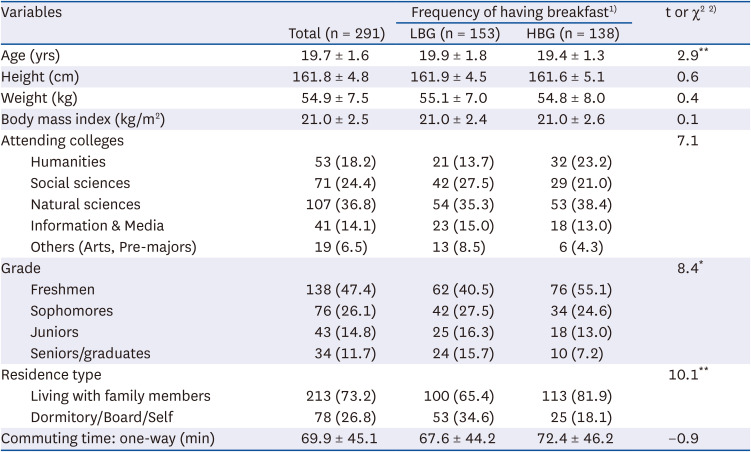
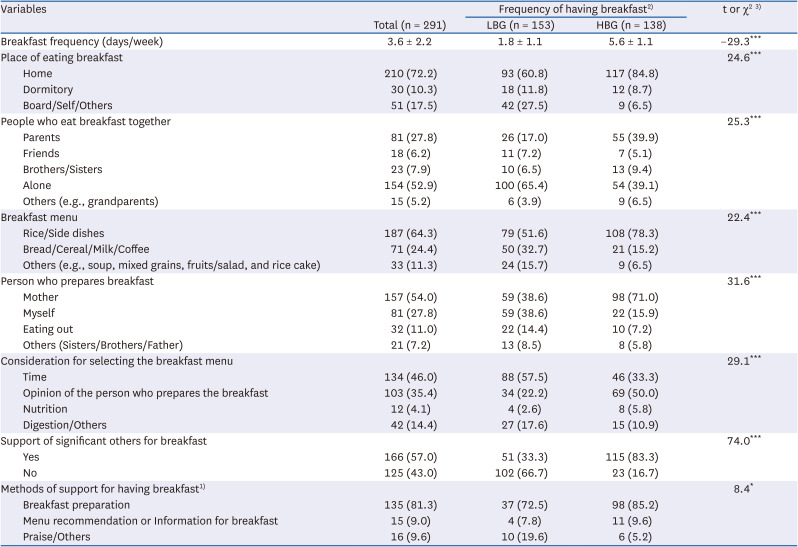
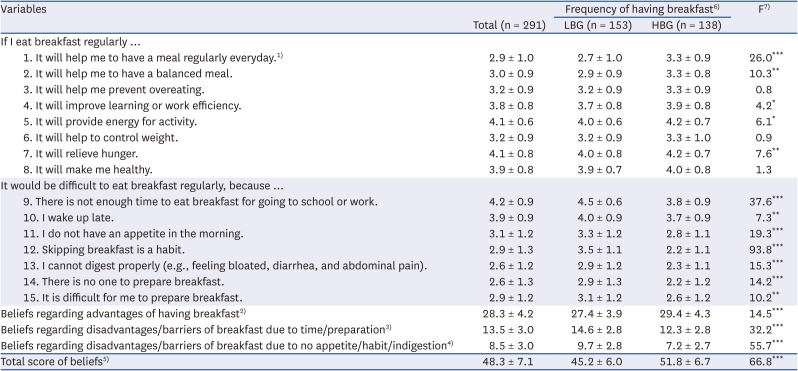
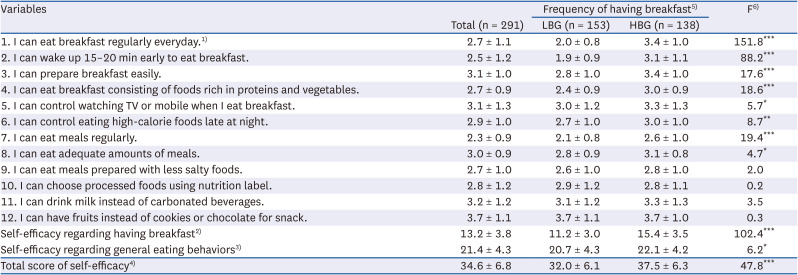
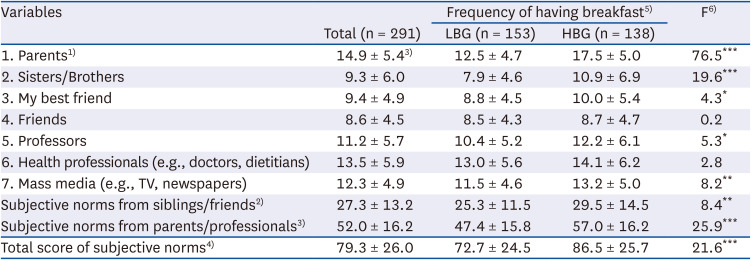
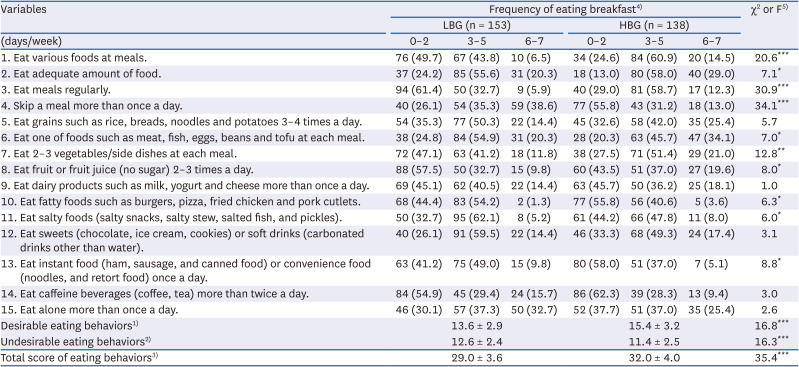






 PDF
PDF Citation
Citation Print
Print



 XML Download
XML Download